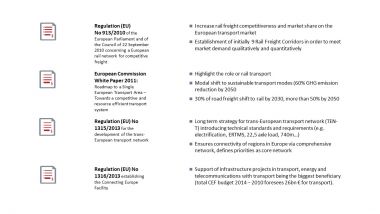
European Context

In 2010, the EU Regulation 913/2010 concerning a European rail network for competitive freight was adopted by the European Parliament and the Council and entered into force on 9 November 2010. It was elaborated with the overall purpose to increase rail freight’s attractiveness and efficiency with special focus on international traffic, so that rail can increase its competitiveness and market share on the European transport market.
It defined the establishment of 9 initial Rail Freight Corridors (RFC), some of them building further on the corresponding ERTMS Corridors. The first six corridors, amongst them also RFC Rhine-Alpine, became operational on the 10th of November 2013. The remaining 3 became operational on the 10th of November 2015. In 2017 and 2018 Rail Freight Corridors 10 and 11 were establised by Commission Implementing Decision (EU) 2017/177 and (EU) 2018/500, respectively. All Rail Freight Corridors together build a European-wide network for competitive freight, making the cooperation among the Rail Freight Corridors essential.
The creation of a Single European Transport Area should ease the movements of citizens and freight, reduce costs and enhance the sustainability of European transport. The role of rail in the establishment of this single European transport area is highlighted in the Transport White Paper, published by the European Commission in 2011. It contains 10 goals for a competitive and resource-efficient transport system and targets a modal shift to sustainable transport modes to achieve a reduction of 60% of the GHG emissions by 2050.
In its White Paper the European Commission also sets the goal that “30 % of road freight over 300km should shift to other modes such as rail or waterborne transport by 2030, and more than 50% by 2050, facilitated by efficient and green freight corridors. To meet this goal will also require appropriate infrastructure to be developed”.
In 2013, the European Commission adopted the following 2 Regulations:
- Regulation (EU) 1315/2013 on Union guidelines for the development of the trans-European transport network
- Regulation (EU) 1316/2013 establishing the Connecting Europe Facility
Within this legal framework, the concept of the Core Network Corridors (CNC) was created. These CNC are multimodal corridors, the rail backbone of which are the above mentioned Rail Freight Corridors (RFC). In order to have maximum consistency and synergy between CNC and RFC, the initial RFCs were amended by Regulation 1316/2013.
Regulation 1315/2013 distinguishes between a core and a comprehensive TEN-T network both for passengers and freight. By 2030, the core network should meet a number of TEN-T requirements. These criteria should be met by 2050 for the comprehensive network. For rail, these criteria include a.o. electrification, ERTMS equipment, 22.5 t axle load, 100km/h and the possibility to run 740m Trains.
The Connecting Europe Facility governs EU funding in the transport sector for the period 2014 – 2020 and supports the development of a network of strategic European infrastructure.
The EEIG Corridor Rhine-Alpine EWIV is thankful for the support from the European Commission, without the help of which, the set-up, development and progress of the corridor organisation would not have been possible.
The corridor benefited from the previous TEN-T support programme in the period from 2007 to 2013 and the co-funding was mainly used for the development of the ERTMS Corridor A and the subsequent establishment as Rail Freight Corridor Rhine – Alpine. Since 2015, the corridor is co-financed through CEF for a period of 4 years for the action “Support and coordination of Rail Freight Corridor Rhine – Alpine for its long-term sustainable operation as required by the EU Regulation 913/2010, 1315/2013 and 1316/2013”.
Apart from the corridor, also individual Infrastructure Managers and Railway Undertakings can benefit from the European funds made available in order to develop an efficient and interoperable railway system.
We present the cookies we use and can use under the link Cookie settings in the privacy policy. Only permissible cookies for which we do not require your consent are preset. You can agree to further functional cookies separately in the cookie settings or by confirming the "Accept" button.
